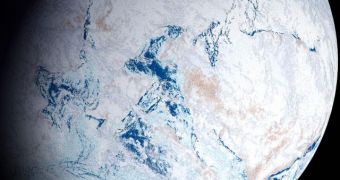We tend to think of the Earth as it is today, covered by water for the most part, with green continents and two white polar ice caps. It's easy to think that it has always been like this, even though we know the planet evolved in time.
But, not only has the Earth only been like this for a relatively short period in its life, it was a wildly different planet not so long ago, long after life had taken over.
One of the most interesting and extreme examples of this is the Snowball Earth hypothesis, the idea that the Earth was completely frozen at least once in its history, completely covered in ice, much like Jupiter's moon Europa is today.
In a new paper published in the journal Nature, scientists now argue that during this period, the liquid ocean below was very much active, despite the common believe.
About 635 million years ago, towards the end of the Neoproterozoic period, the Earth is believed to have been covered in ice from the poles to the equator during at least two periods each lasting a few millions of years.
Life had already been present on the planet for a few billions of years by then, but the most advanced life forms were sponges and similar groups. It was only after these massive ice ages that life began to diversify wildly and it is believed that the ice ages triggered this explosion in diversity.
The new study shows how that might have happened. Up until now, the general consensus was that the ocean beneath the ice, with no influence from the wind, was largely static, meaning there was little exchange of nutrients and species between regions.
But after scientists ran computer simulations of the conditions beneath the ice, they found that the geothermal energy played a much bigger role than believed. The heating from beneath, coupled with the cold ice above generated a lot of activity.
This activity, in turn, led to surprising homogeneity of the conditions in the ocean, salt levels and temperatures were mostly the same around the planet and at all depths. This is in sharp contrast to conditions today, when temperature and salinity vary greatly with depth.
Because conditions were fairly similar everywhere around the planet, much less energy was required to mix water from various regions. This is exactly what happened and this activity meant that nutrients were able to travel faster and further, critical in the harsh conditions of the under ice ocean.

 14 DAY TRIAL //
14 DAY TRIAL //